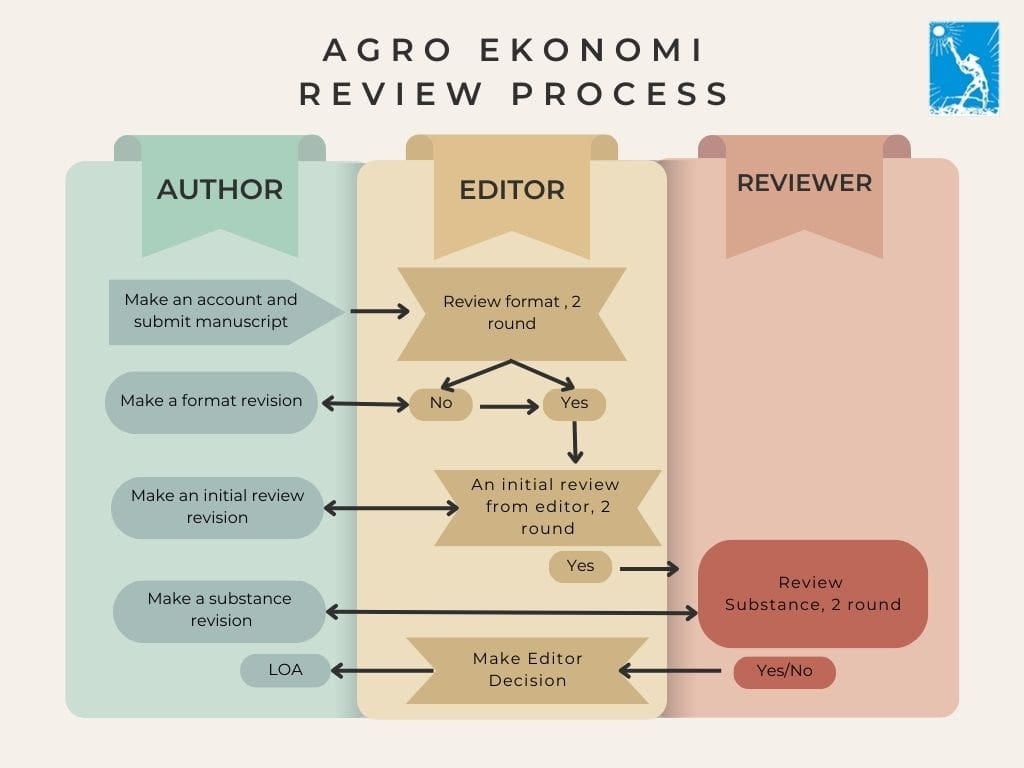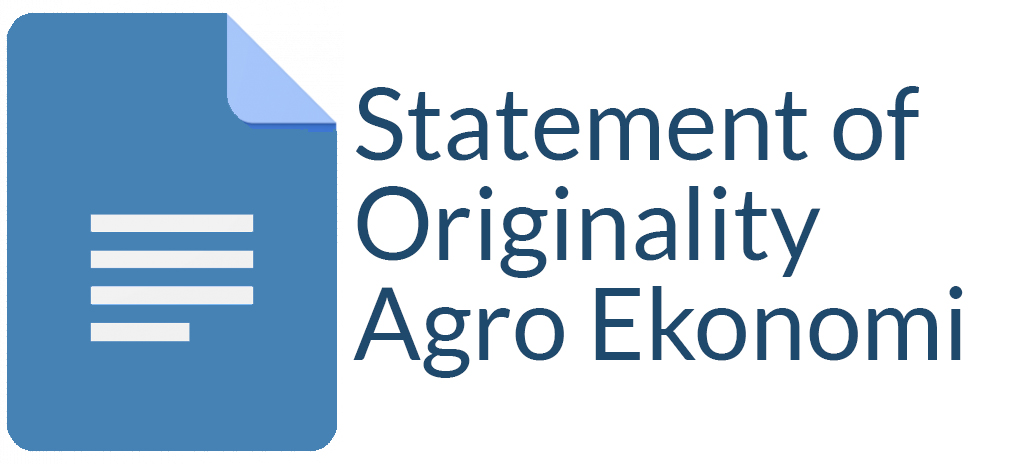Asymmetric Information, Transaction Costs, and Farmers Decision To Participate In Tobacco Voor-Oogst Kasturi Contract Farming
M Rondhi(1*), Rokhani Rokhani(2), Anik Suwandari(3), Kintani Sekarkundi Lahitani(4), Ahmad Fatikhul Khasan(5), Dian Permata Sari(6)
(1) Department of Agricultural Economics, Faculty of Agriculture, The University of Jember
(2) Department of Agricultural Extention, Jember University
(3) Department of Agribusiness, Jember University
(4) Department of Agribusiness, Jember University
(5) Department of Agribusiness, Jember University
(6) Department of Agribusiness, Jember University
(*) Corresponding Author
Abstract
Contract farming is a vital tool to connect farmer and industry. However, contracts participation between tobacco farmers and tobacco leaf supplier (TLS) was still low even though the benefit of the contract is enormous. The low participation was related to factors that affect the contract, demographics, farm characteristic, and other related factors. However, farmer participation on the contract was still low. Besides, contracts initially became a tool to prevent market failure since it regulated how economic actors acted against others causing transaction costs (TC) due to asymmetric information that made the contract not function ideally. Therefore, this study attempts to (1) explain factors underlying farmer decision to participate in contract farming (CF), (2) explain asymmetric information. Respondents in this study were 100 respondents consisting of 50 tobacco contract farmers, and 50 independent farmers. This study applied logistic regression analysis to analyze factors affecting farmer participation in CF. Besides, the New Institutional Economy approach was exerted to analyze asymmetric information on product transfer from farmer to TLS. The results showed that factors that significantly influenced tobacco farmers' decision-making to participate in CF are farming experience, land size, risk aversion level (RAL), the certainty of price, and source of capital. Asymmetric information caused adverse selection and moral hazard. About 30% of farmers had sold products to other parties (other TLSs and middleman), and 8% of farmers had applied pesticides that TLS prohibited. Contracts that were not ideal due to asymmetric information must be re-enforced by using additional costs called transaction costs, divided into three types, (1) search and information costs, (2) cost to design, negotiate and conclude and (3) the monitor and contract enforcement costs. Monitoring costs had the potential to absorb the most considerable portion compared to the other types of transaction costs. The greater the asymmetric information generated, the greater the transaction costs incurred.
Keywords
Full Text:
PDFReferences
Allen, D. W., & Lueck, D. (2002). The Nature of the Farm. MIT Press.
Bellemare, M. F., Barrett, C. B., & Just, D. R. (2013). The Welfare Impacts of Commodity Price Volatility: Evidence from Rural Ethiopia. American Journal of Agricultural Economics, 95(4), 877–899. https://doi.org/10.1093/ajae/aat018
Bellemare, M. F., & Bloem, J. R. (2018). Does Contract Farming Improve Welfare? A review. World Development, 112, 259–271. https://doi.org/10.1016/j.worlddev.2018.08.018
Bellemare, M. F., & Lim, S. (2018). In All Shapes and Colors: Varieties Of Contract Farming. Applied Economic Perspectives and Policy, 40(3), 379–401. https://doi.org/10.1093/AEPP/PPY019
Binswanger, H. P. (1981). Attitudes Toward Risk: Theoretical Implications of an Experiment in Rural India. The Economic Journal, 91(364), 867. https://doi.org/10.2307/2232497
BPS Jember. (2019). Jember dalam Angka 2019. BPS Kabupaten Jember.
Creswell, J. (2013). Qualitative, Quantitative, and Mixed Methods Approaches. In Research design. SAGE Publications Ltd.
Daniel, J. (2012). Sampling Essentials: Practical Guidelines for Making Sampling Choices. SAGE Publications.
Daryanto, A. (2016). Contract Farming: Linking Farmers to Markets. Business and Entrepreneurial Review, 6(1), 27. https://doi.org/10.25105/ber.v6i1.1015
Eaton, C., & Shepherd, A. (2001). Contract Farming: Partnerships for Growth. Food and Agricultural Organization.
Edwards, A. L., & Gonzalez, R. (1993). Simplified Successive Intervals Scaling. Applied Psychological Measurement, 17(1), 21–27.
Hosmer, D. W., & Lemeshow, S. (2000). Applied Logistic Regression. Wiley Series in Probability and Statistic.
Hudson, D., & Lusk, J. (2004). Risk and Transactions Cost In Contracting: Results from A Choice-Based Experiment. Journal of Agricultural and Food Industrial Organization, 2(1), 21–39. https://doi.org/10.2202/1542-0485.1046
Hueth, B., Ligon, E., Wolf, S., & Wu, S. (1999). Incentive Instruments in Fruit and Vegetable Contracts: Input Control, Monitoring, Measuring, and Price Risk. Applied Economic Perspectives and Policy, 21(2), 374–389. https://doi.org/10.2307/1349886
Katchova, A. L., & Miranda, M. J. (2004). Two-Step Econometric Estimation of Farm Characteristics Affecting Marketing Contract Decisions. American Journal of Agricultural Economics, 86(February), 88–102.
Kirsten, J., & Sartorius, K. (2002). 8687966.Pdf. 19(4). https://doi.org/10.1080/037683502200001942
Laffont, J.-J., & Martimot, D. (2002). The Theory of Incentives: The Principal-Agent Model. Princeton University Press.
Lee, J., Gereffi, G., & Beauvais, J. (2012). Global Value Chains and Agrifood Standards: Challenges and Possibilities for Smallholders in Developing Countries. Proceedings of the National Academy of Sciences of the United States of America, 12326–12331.
Lohr, S. L. (2010). Sampling: Design and Analysis (2nd ed.). Duxbury Press.
Long, J. S. (1997). Regression Models for Categorical and Limited Dependent Variables. In ALong, J. S. (1997). Regression Models for Categorical and Limited Dependent Variables. In Advanced Quantitative Techniques in the Social Sciences. SAGE Publications Ltd.dvanced Quantitative Techniques in the Social Sciences. SAGE Publications Ltd.
MacDonald, J. M., & Korb, P. (2012). Agricultural Contracting Update: Contracts in 2008. Ssrn, 72. https://doi.org/10.2139/ssrn.2114442
MacDonald, J. M., Perry, J., Hearn, M. A., Banker, D., Chambers, W., Damitri, C., Key, N., Nelson, K. E., & Southard, L. W. (2004). Contract, Markets, and Price: Organizing the Production and Use of Agricultural Commodities.
Menard, C., & Shirley, M. M. (2008). Handbook of New Institutional Economics. Springer.
Minot, N., & Sawyer, B. (2014). Contract Farming in Developing Countries : Theory, Practice, and Policy Implications. In E. André Devaux, Ed., Maximo Torero, Ed., Jason Donovan, Ed., Douglas E. Horton (Ed.), Innovation for inclusive value-chain development: Successes and challenges (Issue May, pp. 127–155).
Mishra, A. K., Kumar, A., Joshi, P. K., D’Souza, A., & Tripathi, G. (2018). How Can Organic Rice Be A Boon to Smallholders? Evidence From Contract Farming In India. Food Policy, 75(August 2017), 147–157. https://doi.org/10.1016/j.foodpol.2018.01.007
Miyata, S., Minot, N., & Hu, D. (2009). Impact of Contract Farming on Income: Linking Small Farmers, Packers, and Supermarkets in China. World Development, 37(11), 1781–1790. https://doi.org/10.1016/j.worlddev.2008.08.025
Nandhita, L., & Rondhi, M. (2018). Pola Kemitraan Petani Cabai Merah dengan Koperasi di Desa Andongsari Kecamatan Ambulu Kabupaten Jember. Pembangunan Pertanian Dan Peran Pendidikan Tinggi Agribisnis: Peluang Dan Tantangan Di Era Industri 4.0, November, 344–349.
North, D. C. (1990). Institutions, Institutional Change and Economic Performance. In Cambridge University Press. https://doi.org/10.1017/CBO9780511606892.012
Paulson, N. D., Katchova, A. L., & Lence, S. H. (2010). An Empirical Analysis of The Determinants of Marketing Contract Structures for Corn and Soybeans. Journal of Agricultural and Food Industrial Organization, 8(1). https://doi.org/10.2202/1542-0485.1282
Pennings, J. M. E., & Garcia, P. (2001). Measuring Producers’ Risk Preferences: A Global Risk-Attitude Construct. American Journal of Agricultural Economics, 83(4), 993–1009. https://doi.org/10.1111/0002-9092.00225
Pennings, J. M. E., & Leuthold, R. M. (2000). The Role of Farmers’ Behavioural Attitudes and Heterogeneity In Futures Contract Usage. American Journal of Agricultural Economics, 82(4), 908–919.
Poku, A. G., Birner, R., & Gupta, S. (2018). Making Contract Farming Arrangements Work in Africa’s Bioeconomy: Evidence from Cassava Outgrower Schemes In Ghana. Sustainability (Switzerland), 10(5), 8–10. https://doi.org/10.3390/su10051604
Putri, A. T. R., & Rondhi, M. (2020). Contract Farming and The Effect on Price Risk in Broiler Farming. In M. Rondhi & H. S. Addy (Eds.), International Conference on Agricultural and Life Science (Vol. 05002, pp. 1–5). E3S Web of Conferences. https://doi.org/https://doi.org/10.1051/e3sconf/202014205002
Reardon, T., Barrett, C. B., Berdegué, J. A., & Swinnen, J. F. M. (2009). Agrifood Industry Transformation and Small Farmers in Developing Countries. World Development, 37(11), 1717–1727. https://doi.org/10.1016/j.worlddev.2008.08.023
Reardon, T., & Timmer, C. P. (2014). Five Inter-Linked Transformations in The Asian Agrifood Economy: Food Security Implications. Global Food Security, 3(2), 108–117. https://doi.org/10.1016/j.gfs.2014.02.001
Rondhi, M., Imelda, S., Setyawan, H., Aji, J. M. M., Hariyati, Y., M, M., Raharto, S., Fauziah, D., & Kusmiati, A. (2020a). Asymmetric Information And Farmer’s Participation In Tobacco Contract Farming. Jejak, 13(1), 84–102. https://doi.org/10.15294/jejak.v13i1.17413
Rueda, X., Garrett, R. D., & Lambin, E. F. (2016). Corporate Investments in Supply Chain Sustainability : Selecting Instruments in The Agri-Food Industry. Journal of Cleaner Production. https://doi.org/10.1016/j.jclepro.2016.11.026
Saenger, C., Qaim, M., Torero, M., & Viceisza, A. (2013). Contract Farming and Smallholder Incentives to Produce High Quality: Experimental Evidence from The Vietnamese Dairy Sector. Agricultural Economics (United Kingdom), 44(3), 297–308. https://doi.org/10.1111/agec.12012
Suli, D., Bombaj, F., Aliaj, N., & Suli, H. (2013). A New Institutional Economics Approach to Contracts and Cooperatives. Mediterranean Journal of Social Sciences, 4(9), 64–68. https://doi.org/10.5901/mjss.2013.v4n9p64
Vassalos, M., & Li, Y. (2016). Assessing The Impact of Fresh Vegetable Growers’ Risk Aversion Levels and Risk Preferences on The Probability of Adopting Marketing Contracts: A Bayesian Approach. International Food and Agribusiness Management Review, 19(1), 25–42.
Williamson, O. E. (1996). The Mechanism of Governance. Oxford University Press.
Article Metrics
Refbacks
- There are currently no refbacks.
Copyright (c) 2018 Agro Ekonomi

This work is licensed under a Creative Commons Attribution-ShareAlike 4.0 International License.
Statcounter View My Stats











